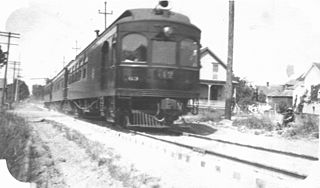
The Oregon Electric Railway (OE) was an interurban railroad line in the U.S. state of Oregon that linked Portland to Eugene.
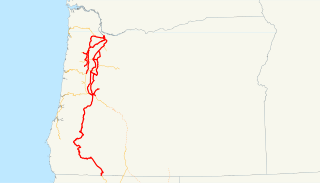
The Oregon and California Railroad was formed from the Oregon Central Railroad when it was the first to operate a 20-mile (32 km) stretch south of Portland in 1869. This qualified the railroad for land grants in California, whereupon the name of the railroad soon changed to Oregon & California Rail Road Company. In 1887, the line was completed over Siskiyou Summit, and the Southern Pacific Railroad assumed control of the railroad, although it was not officially sold to Southern Pacific until January 3, 1927. This route was eventually spun off from the Southern Pacific as the Central Oregon and Pacific Railroad.
The Tualatin Valley Highway No. 29 is an Oregon highway which passes through the Tualatin Valley, between the cities of McMinnville and Beaverton. Between McMinnville and Forest Grove, the highway is signed as Oregon Route 47; between Forest Grove and Beaverton it is signed as Oregon Route 8. Oregon 8 becomes Canyon Road in Beaverton east of Hocken Road.

The Portland and Western Railroad is a 516-mile (830 km) Class II railroad serving the U.S. state of Oregon, and is a wholly owned subsidiary of shortline and regional railroad holding company Genesee & Wyoming Inc. The PNWR includes a subsidiary, the Willamette and Pacific Railroad.

The Central Branch Union Pacific Railroad was a railroad in the U.S. state of Kansas. Originally planned as a line from Atchison west into Colorado, and given federal land grants by the Pacific Railway Act of 1862 as one of the branches of the Union Pacific Railroad, it was left with a hanging end at Waterville, Kansas, when the Union Pacific Railway, Eastern Division, with which it was to connect, changed its route. The line was acquired by the Union Pacific through a stock purchase by Jay Gould and leased to the Missouri Pacific Railroad in 1880. In 1909 the Central Branch was merged into the Missouri Pacific; the latter company came back into the Union Pacific system in 1982. In 1991 the remaining trackage west of Frankfort was leased to the Kyle Railroad.
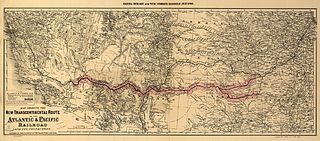
The Atlantic and Pacific Railroad was a U.S. railroad that owned or operated two disjointed segments, one connecting St. Louis, Missouri with Tulsa, Oklahoma, and the other connecting Albuquerque, New Mexico with Needles in Southern California. It was incorporated by the U.S. Congress in 1866 as a transcontinental railroad connecting Springfield, Missouri and Van Buren, Arkansas with California. The central portion was never constructed, and the two halves later became parts of the St. Louis-San Francisco Railway and Atchison, Topeka and Santa Fe Railway systems, now both merged into the BNSF Railway.
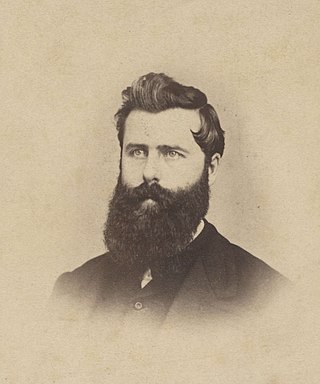
Joseph Norton Dolph was an American politician and attorney in the state of Oregon. A native of the state of New York, he immigrated to Oregon over the Oregon Trail and settled in Portland where he became the state's federal district attorney. A Republican, he spent nine years in the Oregon State Senate before serving in the United States Senate from 1883 to 1895.

Benjamin Holladay was an American transportation businessman responsible for creating the Overland Stage to California during the height of the 1849 California Gold Rush. He created a stagecoach empire and is known in history as the "Stagecoach King".

The Oregon land fraud scandal of the early 20th century involved U.S. government land grants in the U.S. state of Oregon being illegally obtained with the assistance of public officials. Most of Oregon's U.S. congressional delegation received indictments in the case: U.S. Senator John H. Mitchell and U.S. Representatives John N. Williamson and Binger Hermann, with Senator Charles William Fulton singularly uninvolved.
The Sioux City and Pacific Railroad was a railroad in the U.S. states of Iowa and Nebraska. Built as a connection from Sioux City, Iowa to the Union Pacific Railroad at Fremont, Nebraska, it became part of the Chicago and North Western Railway system in the 1880s, and is now a main line of the Union Pacific (UP). The east–west portion from Fremont to Missouri Valley, Iowa, is the Blair Subdivision, carrying mainly westbound UP trains, and the line from California Junction, Iowa north to Sioux City is the Sioux City Subdivision.
The Puget Sound Shore Railroad and successor Northern Pacific and Puget Sound Shore Railroad built a branch line of the Northern Pacific Railroad between Puyallup and Seattle, Washington, U.S., and partially constructed a line around the east side of Lake Washington to Woodinville.

William Lair Hill, also referred to as W. Lair Hill, was an American attorney, historian, and newspaper editor in Portland, Oregon. He worked to codify Oregon's and Washington's laws. He briefly owned property in the Portland neighborhood later named after him, Lair Hill.
Saint Joseph is an unincorporated community in Yamhill County, Oregon, United States. It is located about two miles west of Lafayette near Oregon Route 99W. The area is sometimes known as "St. Joe".

The Southern Pacific Red Electric Lines, also known simply as the Red Electric, was a network of interurban passenger train services operated by the Southern Pacific Railroad in the Willamette Valley of the U.S. state of Oregon from 1914 to 1929. The service got its name from the bright red color of its cars. Despite its short history, among West Coast interurbans it was unique, and it was considered the finest such system in the Pacific Northwest. It was the only major electric interurban railroad converted from steam to electric passenger use. It was also one of few systems using all-steel equipment, and one of the largest 1500-volt systems in the country.
The Coos Bay Wagon Road Lands is land managed by the United States Bureau of Land Management. The land was originally granted to the Oregon & California Railroad to create a road between Coos Bay, Oregon, and Roseburg, Oregon. The land was reconveyed to the United States in 1937.
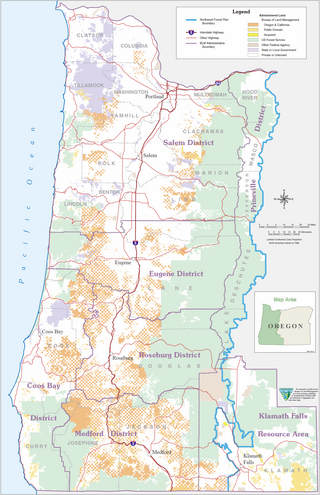
The Oregon and California Railroad Revested Lands, are approximately 2,600,000 acres (1,100,000 ha) of land located in eighteen counties of western Oregon. Originally granted to the Oregon & California Railroad to build a railroad between Portland, Oregon and San Francisco, California, the land was reconveyed to the United States government by act of Congress in 1916 and is currently managed by the United States Bureau of Land Management.
The Portland Street Railway Company was the first mass transit company and streetcar line in Portland, Oregon, United States. Founded in 1872 by transportation magnate Ben Holladay, it operated horsecars on a two-mile (3.2 km) narrow gauge line on First Street, from a barn on Glisan Street in the north to Porter Street in the south.

Joseph P. Gaston was an American railroad executive, journalist, and historian based in Oregon. He is remembered as the namesake of Gaston, Oregon, the Joseph Gaston House, and the Gaston-Strong House. Gaston was the first president of the Oregon Central Railroad and an outspoken opponent of railroad executive Ben Holladay. He authored the three-volume Portland, Oregon, Its History and Builders and the four-volume The Centennial History of Oregon, 1811 to 1911.

The People's Transportation Company operated steamboats on the Willamette River and its tributaries, the Yamhill and Tualatin rivers, in the State of Oregon from 1862 to 1871. For a brief time this company operated steamers on the Columbia River, and for about two months in 1864, the company operated a small steamer on the Clackamas River.
The Tigard branch is a short railway line on the west side of Portland, Oregon, in the United States. It connects the Union Pacific Railroad's West Side branch and Newberg branch. It was originally built in 1910 by the Beaverton and Willsburg Railroad, a subsidiary of the Southern Pacific Transportation Company. The Portland and Western Railroad operates the line, including the WES Commuter Rail service.













